Within the world of diving, there are three groups: those who dive with computers, those who dive with tables, and those who do neither, instead opting to simply follow the fins in front of them. It is a growing trend in many areas across the world that dive computers are becoming mandatory per diver, and for good reason. The dive computer was one of the most revolutionary developments within the diving industry, contributing to increased diver safety and greater decompression accuracy. Though it is perfectly possible to dive without a computer, using tables and a depth gauge/bottom timer instead, the dive computer can do all the things the former can but with far greater precision. By the end of reading our product recommendations and buyers advice guide, you will be equipped to make an informed decision as to which is the best dive computer for you and your needs.
Best Dive Computers Reviewed
#1 – Shearwater Perdix (Best Technical Dive Computer)
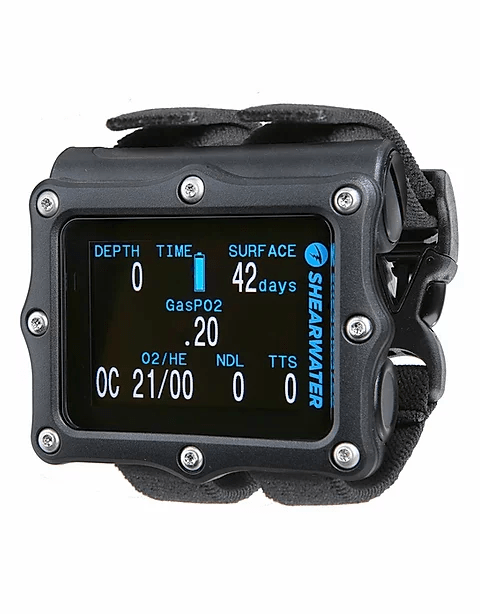
Shearwater is a Canadian company leading the market in dive computers. Their dive computers are used by many of the most advanced divers, on the most extreme of dives. Their quality surpasses almost all other dive computers on the market. The Shearwater Perdix sits at the top of this spear of excellence. It is one of the best full trimix technical dive computers currently on the market, with unique features such as ‘GF99’ and ‘@+5’ among many others. The Perdix runs four diving modes, appealing to recreational, open circuit technical and closed circuit rebreather divers. The Perdix has a very easy operating system, with a simple two button interface. The only drawback to this dive computer is its high price. For the solely recreational diver, the Perdix comes with many features that will never be used. Therefore, unless price is not an issue, there are other more cost-effective options for purely recreational divers.
Features:
- High resolution, 2.2” screen.
- User-customisable display, allowing the diver to select what is important for them.
- Two button interface making for easy, user-friendly operation.
- User replaceable battery.
- Tilt compensating digital compass.
- Dive log of 1,000 hours. Able to upload dive information and profile via bluetooth to computer.
- Depth rated to 260m.
Drawbacks:
- Price.
- For the recreational diver, it comes with many features that they will never use.
#2 – Shearwater Teric (Best Technical Dive Computer 2.0)
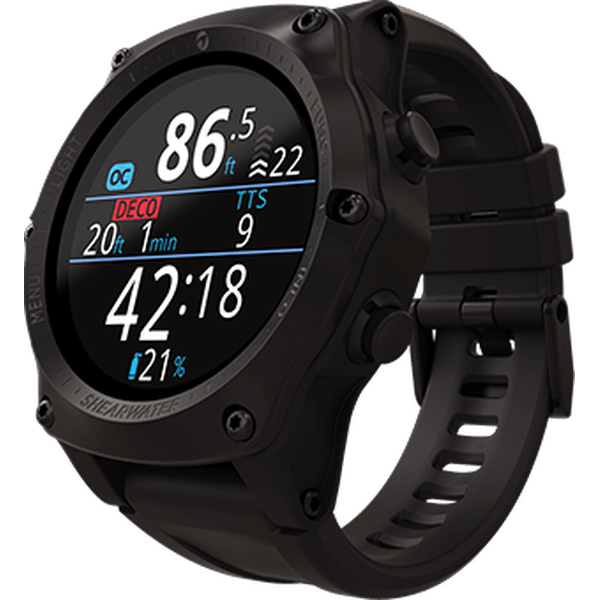
The Shearwater Teric is almost identical to its predecessor, the Perdix. The only difference is its build. The Teric is able to be worn as an everyday wrist watch, and Shearwater themselves market it as something that can be worn both in the water and ‘in the corporate boardroom’. For divers wanting a dive computer with capabilities identical to the Perdix, but in a smaller, wrist watch style size, the Teric is the computer for them.
Features:
- High resolution, 1.39” screen.
- User-customisable display, allowing the diver to select what is important for them.
- User-friendly operation.
- Low profile design – wearable as an everyday wrist watch.
- Dive log of 500 hours. Able to upload dive information and profile via bluetooth to computer.
- Depth rated to 200m.
Drawbacks:
- Price.
- For the recreational diver, it comes with many features that they will never use.
#3 – Shearwater Peregrine (Cost-Effective Extended Range Dive Computer)
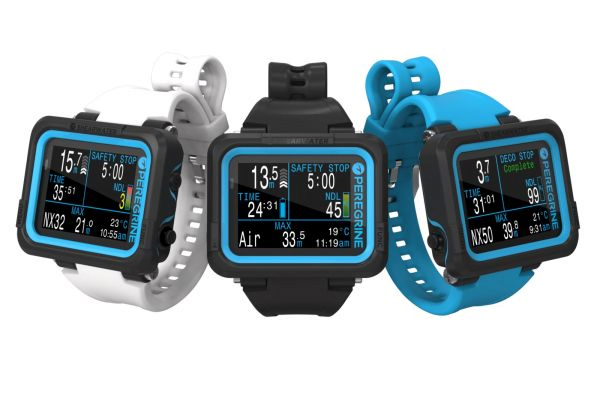
Shearwater’s newest addition, the Peregrine offers the diver a computer capable of handling technical dives that don’t involve trimix. This computer is perfect for both recreational divers and those engaging in extended range air dives without the wish to use trimix. Consequently, as it is not a full trimix computer, it comes at a lower price than other Shearwater dive computers. For the majority of divers, this is an excellent computer which will serve all their needs throughout their whole diving career.
Features:
- 4 diving modes: Air, Nitrox, 3 Gas Nitrox, and Gauge.
- Capable of loading Nitrox mixtures up to 100%.
- High resolution, 2.2” screen.
- User-customisable display, allowing the diver to select what is important for them.
- Dive planning mode.
- Dive log of 200 hours.
- Depth rated to 120m.
Drawbacks:
- Not a full trimix computer – only a problem for those wishing to dive with trimix.
- No compass – only a problem if that is desired in a computer.
#4 – Suunto D5 (Best High End Recreational Dive Computer)
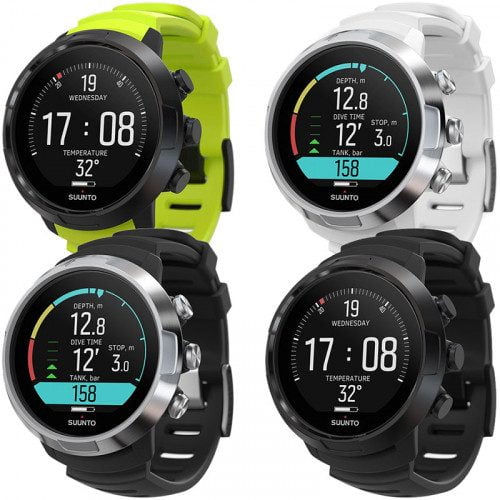
The Suunto D5 is a computer that will fulfill all the needs of recreational divers as well as those in the shallower end of technical diving. It is capable of loading 3 gases, as well as performing in-water gas switches. It utilises the Suunto fused RGBM decompression model, as all Suunto computers do. The price range is middle to high for this product, but it is a great choice for the majority of divers who are serious. Unlike the Peregrine, the Suunto D5 can also be worn as an everyday wrist watch, making it the best choice for many divers.
Features:
- Air, Nitrox and Freediving mode.
- Digital compass.
- Air integration.
- 200 hours or 400 dives worth of logbook.
- Multiple dive warnings and alarms built in.
- Depth rated to 100m.
Drawbacks:
- Not a full trimix computer, and not capable of loading 100% Oxygen into decompression gas selection – limiting decompression and dive options (but only a problem for those wishing to do technical diving).
- Unable to change the decompression algorithm to Buhlmann or VPM.
#5 – Suunto D4i (Best Recreational Dive Computer)
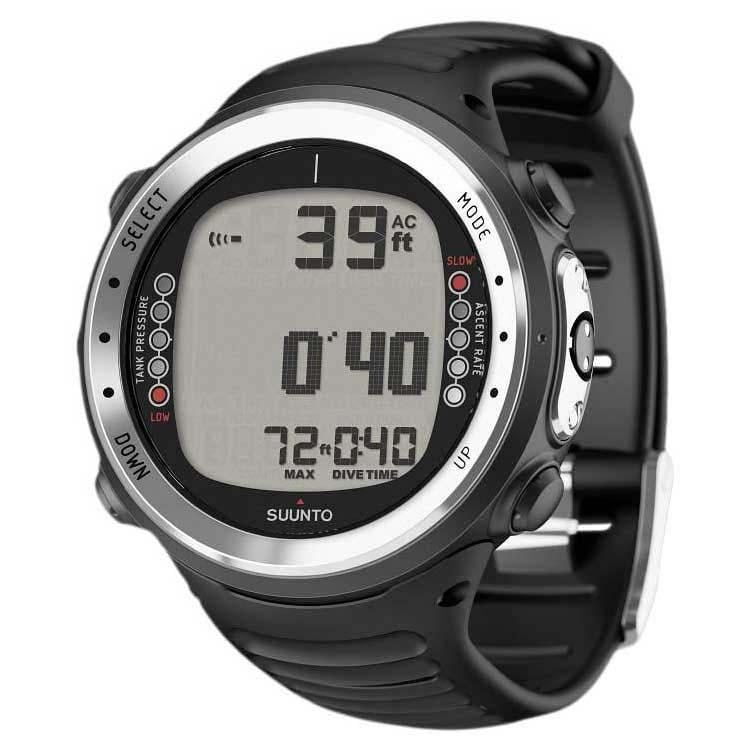
The Suunto D4i is a very good choice of dive computer for all recreational divers. With a user-friendly operating system and a wrist watch design, this computer suits the needs of most divers. Its small low profile design makes it very streamlined when diving, compared to other recreational dive computers which are far more bulky and protruding. This dive computer also comes at a very affordable price, making it even more of an attractive option.
Features:
- Air integration.
- Depth rated to 100m.
- Simple, user-friendly operation.
- Small, low profile design.
- Timer/stopwatch.
- Wearable as an everyday wrist watch.
Drawbacks:
- Is only suitable for recreational diving.
#6 – Suunto Zoop Novo (Best Beginner/Cheap Recreational Dive Computer)
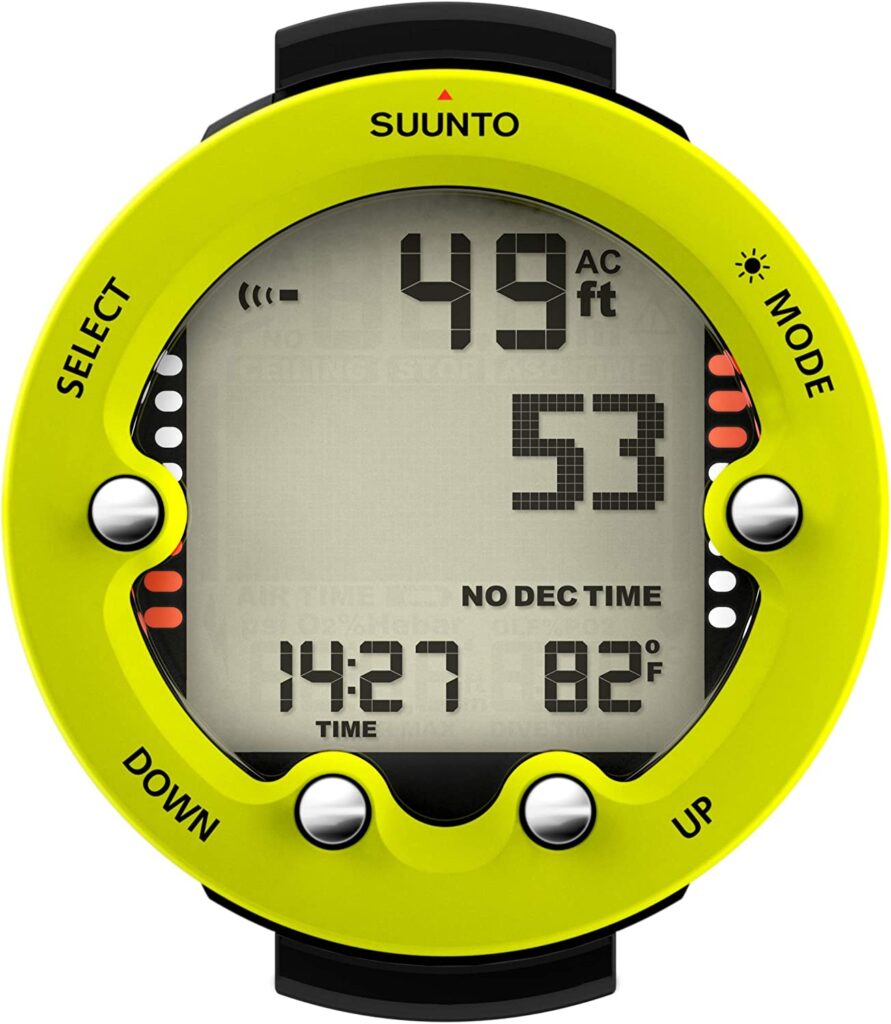
The Suunto Zoop Novo is a good choice of dive computer for those wanting a cost-effective option for use only within recreational diving limits. It has a very user-friendly operating system with a large display, making it easy to use from the outset. The drawbacks of this computer, however, are that it is large and protruding, making it less than streamlined in the water, as well as it being a solely recreational computer. If you have any plans of moving into the world of technical diving, this is not the computer for you. But, if you simply want to enjoy recreational diving without spending huge amounts on a dive computer, then this may be a great, cost-effective purchase for you.
Features:
- Air, Nitrox, and freediving modes.
- Suunto RGBM.
- Simple, user-friendly operation.
- 140 hours of logbook memory.
- Depth rated to 80m.
Drawbacks:
- Basic computer, with few additional features.
- Big, bulky profile.
Picking The Best Dive Computer
The Benefits of a Dive Computer
The dive computer is a tool that has revolutionised diving. It has simplified the diving experience, making for safer, easier and more flexible diving. The benefits of the dive computer include greater self-reliance, greater dive profile accuracy, longer dives, longer repetitive dives, conservatism adjustments, in-water oxygen exposure tracking, in-water gradient factor tracking, and the ability to log and save all this information.
Increased self-reliance
Increased self-reliance is arguably one of the primary benefits of having a dive computer. Whether or not we may like to admit it, there are dive operators in the world whose safety standards are less than exemplary. There are dive centres who will employ staff who may only be beginner divers themselves, to guide groups of customers. This occurs most commonly on zero-to-hero or work in exchange for free Divemaster course schemes. Having no personnel or dive guides who are professionally trained as Divemasters or equivalent poses a serious safety issue.
Similarly, though less commonly, there are some trained dive guides and even instructors who manage to slip through the net with a total disregard for matters of safety. For those customers unfortunate enough to land themselves in the group led by these guides, it is essential that they have the ability to conduct their dives safely and independently of the guide, even if they follow along with the rest of the group. For example, if the dive guide goes beyond normal depth limits, or exceeds an NDL, the diver who owns a computer (and has the ability and confidence to use it properly), will be able to avoid following along with these dangerous behaviours.
Similarly, in an alternative situation, if the diver got separated from their buddy and the rest of the group, they would have the necessary tools to be able to carry out the dive alone and reach the surface safely. This makes the diver with the dive computer far more self-reliant, with heightened situational awareness, which in turn increases safety for others who dive with them, as they become a more useful team member.
Ability To Track Dives
Another benefit of dive computers is that the user is able to continuously track their dive profile, giving them the most accurate NDL possible. On top of this, in more advanced dive computers, the user is able to alter the conservatism of their dive profile with the use of gradient factors. Similarly, in advanced dive computers, total oxygen exposure is also tracked, which is significant for those utilising rich nitrox mixtures and pure oxygen for decompression.
All the information a dive computer offers is recorded and logged. This means that the user has the ability to look for patterns across dives, as well as make comparisons. This could be anything from total dive time, to maximum depth, to temperature. This has the result of allowing them to consider the differences in dive conditions, and how this is related to changes in their diving experience. For example, let’s say a diver did a deep dive in Bermuda and another deep dive in the North Sea. On the North Sea dive, they experienced a far higher level of narcosis. The diver, therefore, could compare differences in temperature and how that affected their susceptibility to narcosis – as an example. The logging of dives, and comparison of different factors will only help to make them more aware; and greater awareness breeds greater safety.
The Features of a Dive Computer
Different dive computers come with different features. In most cases, the higher the price, the more features. In your selection of the best dive computer, knowing what you need and knowing what is unnecessary is paramount in determining both what to look for and the price range. All dive computers will give you depth, run time and NDL. These three values are the baselines that separate a dive computer from a watch. Apart from these, there are other features to consider.
The most useful thing to do is summon your crystal ball, and look into the future: what is your diving career going to look like? Do you see yourself moving into technical diving, exploring deep wrecks with multiple gas mixtures and long decompressions. Or, do you see yourself staying purely within the shallower recreational range? This is a vital consideration to make, and will ensure that the investment you make is long-lasting and worthwhile. It would be foolish to invest hundreds in a computer rich with features you will never use. Likewise, it is less than smart to invest in a dive computer which you will soon out-grow. The various features of dive computers will be discussed below, in order for you to figure out exactly what it is you need and don’t need.
Ascent Rate Monitor
Apart from the three basic features of a dive computer (depth, run time, NDL reading), the majority of dive computers also come with an ascent rate monitor. This is a very useful feature, especially for new divers, in order to accurately gauge the speed at which they are ascending. For beginners, this feature enables them to get the feeling for the correct ascent rate to use, as the dive computer will have some sort of alarm and/or vibration if the safe ascent rate is exceeded. This is a useful aid in helping new divers to gauge the correct speed at which to ascend, so that it gradually becomes intuitive with experience. Similarly, an ascent rate monitor is also very effective in making blue water ascents safer and easier. Without a visual reference point, ascending in the blue can be a very difficult task, particularly for those inexperienced in doing so. However, with a dive computer, the user is able to continuously monitor their depth and ascend at a safe rate, even without a visual point of reference. Most basic to medium level dive computers operate with a series of alarms and/or vibrations in order to alert the diver to their ascent rate. However, in high end dive computers, these alarms are often supplemented with an actual numerical reading, i.e. your ascent rate in metres or feet per minute. This is extremely useful for technical divers who often utilise different ascent rates based upon which part of the decompression profile they are at.
Built In Digital Compass
It is now fairly common for medium to high end dive computers to have a built-in digital compass. This feature is not strictly necessary for any type of diving, as a simple wrist mounted compass is very effective and also keeps the two instruments separate, thereby increasing redundancy. However, many divers like this built-in feature and find it very useful and user-friendly. If you believe this is a feature you would like to have then you should at least ensure that the compass is tilt-compensating.
Dive Log Memory
A dive log memory is also common among all dive computers, allowing the data of each dive to be saved. The amount of memory available depends on the specific computer. This feature, whilst convenient, is not usually a factor that divers put the most emphasis on, especially as many log their dives by alternative means (e.g. by paper or with an app). On a similar note, some dive computers are wearable as an everyday wrist watch, whilst some are used purely for diving. This again comes down to a matter of personal preference and does not determine how good the dive computer is; it is simply a matter of preference. Some divers prefer a large screen, designed solely for the purposes of diving; others prefer something they can wear and use both underwater and topside.
The Features of a Technical Diving Computer
Given the extreme nature of technical diving, there are certain elements which are highly desirable in a dive computer. Among these are: transparent and changeable decompression algorithms, no lockout feature, ability to modify conservatism/decompression profile on-the-fly whilst in-water, ability to switch between multiple gases, numerical ascent rate reading, and user-friendly operation.
Decompression Algorithm
Firstly, the decompression algorithm. The most common algorithms are Buhlmann ZHL-16-C and VPM-B. The former is a dissolved gas model; the latter a dual phase model. When selecting a dive computer for technical diving, this is arguably the most important feature, as the algorithm dictates how the decompression profile will be calculated and distributed. Both ZHL-16-C and VPM-B allow the diver to modify the degree of conservatism, as well as the depth of the first stop. Similarly, both algorithms are used by the two most popular decompression planning softwares: Multideco and V-Planner. There are some dive computers marketed as technical diving computers which either do not use these algorithms, use a modified version of these algorithms, and/or do not allow the user to modify the conservatism nor the first stop depth of their decompression profile. This presents serious problems as users will not be able to accurately control their decompression profile based on their own individual physiological preferences. A dive computer not allowing the option of decompression algorithm modification should be stayed clear of in all cases. Similarly, the problem of some of these recondite algorithms and operating systems is that they are often unpredictable, and may suddenly give the user a longer decompression obligation than was planned based on factors not made clear by the manufacturers. These are some reported examples which have contributed to a sudden increase in decompression obligation: a sudden violation of the safe ascent rate, a dive deeper than the previous dive, and calculating multi-day repetitive diving. These factors are just a few that can cause some algorithms to act in an unpredictable manner. This unpredictable manner is of course a danger to technical divers, as decompression obligations and consequent gas requirements are calculated before the dive, and the latter cannot be changed once immersed.
No Lockout Feature
A second important feature in a good technical dive computer, tying in with the previous point, is that of no lockout features. In some dive computers, if a decompression stop is missed, an ascent rate violated, or any other disruption to the calculated plan occurs, the computer will ‘lockout’ the user, making the computer useless. In high-end technical dive computers, however, they will continuously recalculate the dive profile and ascent, ensuring to stay with you all the way until the dive is over. This is a critical aspect to look for in a dive computer that will be used for technical diving, as a dive plan must always make room for contingencies, and, therefore, so should the dive computer too.
Gas Mixtures Switching
Another feature that is of paramount importance in a technical dive computer is that of the ability to switch between different gas mixtures whilst immersed. Technical divers carry multiple tanks filled with different variations of nitrox and trimix, as well as pure oxygen, which are used for different phases of the dive. As the decompression profile is carried out, the diver will switch to gas mixtures with higher percentages of oxygen, in order to facilitate off-gassing. However, a good technical dive computer must be able to also switch to the same gas being switched to, so that it can recalculate the decompression profile based on the new gas mixture being breathed. Most good technical dive computers will allow at least 5 different gases to be switched between throughout the dive, with some allowing up to 10.
Numerical Ascent Reading
Another feature, though non-essential, is also desired in a technical dive computer. That is, a numerical ascent rate reading (i.e. metres/feet per minute). This allows technical divers to monitor and vary their ascent rates with accuracy. This is a very useful feature as technical dives are planned based on specific numerically represented ascent rates. For dives in the 100m range and deeper, minor variations in ascent rates can make massive differences in the total amount of decompression required. Similarly, a computer featuring a numerical ascent rate reading will usually also have the same for descent. This too is important, as technical dives are also planned with specific descent rates, for the purpose of minimising total decompression obligations.
User Friendly
On top of the previous features, a dive computer which is user-friendly and simple is desirable. A dive computer utilising a two button operation system is an example of such. On the other hand, dive computers with numerous buttons and complex operating systems are an unnecessary distraction and should be avoided when possible.
Diving Without a Dive Computer
It is completely possible to dive without a dive computer. This has been done for many decades previously and still is done so by many divers today. This is performed with the use of dive tables, which prescribe the No Decompression Limit (NDL) for each given depth. The NDL is simply the amount of time a diver can spend at a given depth without having to perform mandatory decompression stops. Dive tables also calculate the amount of residual nitrogen left in the diver’s tissues after surfacing, allowing for repetitive diving with adjusted NDLs for each depth.
The diver selects in advance of the dive what the maximum depth will be and finds out the NDL for this depth. Then, they simply use a bottom timer and a depth gauge to ensure they do not exceed the depth nor time limit. For repetitive dives, the diver will find out how much residual nitrogen they have left in their tissues based on the maximum depth of the previous dive and the length of the surface interval since the end of the last dive. The combination of these two values give them a pressure group, categorised by the letter A to Z. They then use this pressure group to find out what the new, recalculated NDL is for the maximum depth of their next dive. A dive table looks something like that below.
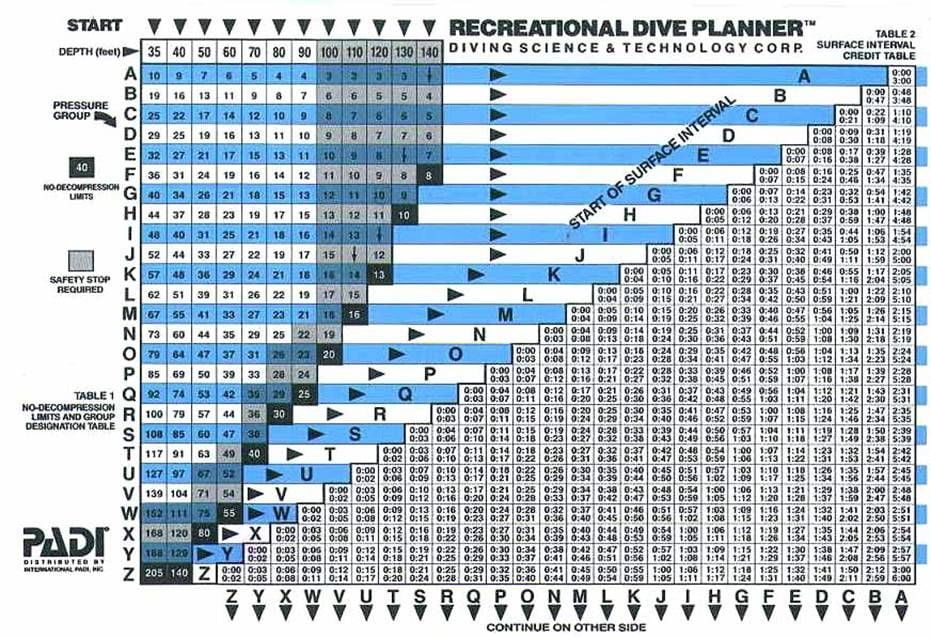
It’s likely that the above explanation may make dive tables sound like a nightmarish task of complexity. In reality, they are simple enough to use and are much easier to understand when someone guides you through them in person. However, the use of dive tables come with a range of unavoidable drawbacks.
One of the primary problems of dive table usage is that of freedom and accuracy. A dive table assumes that the diver will dive a square profile. A square profile is simply one in which the diver descends directly to their maximum depth, spends the planned amount of time at this depth, and then descends directly to the surface (of course at the correct ascent speed and with a safety stop). This is demonstrated graphically below.
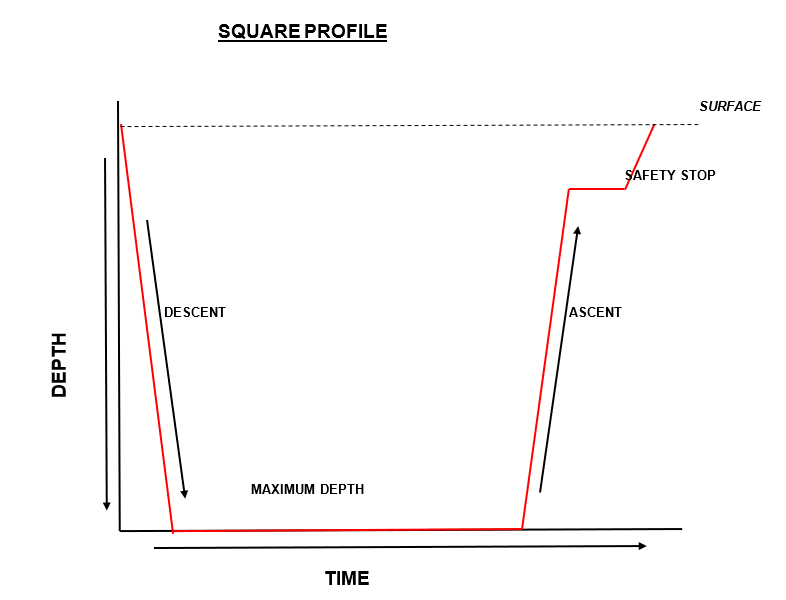
Clearly, as we know, a truly square profile is a rare thing. What is far more common is a profile involving continuous fluctuations in depth, as shown below.
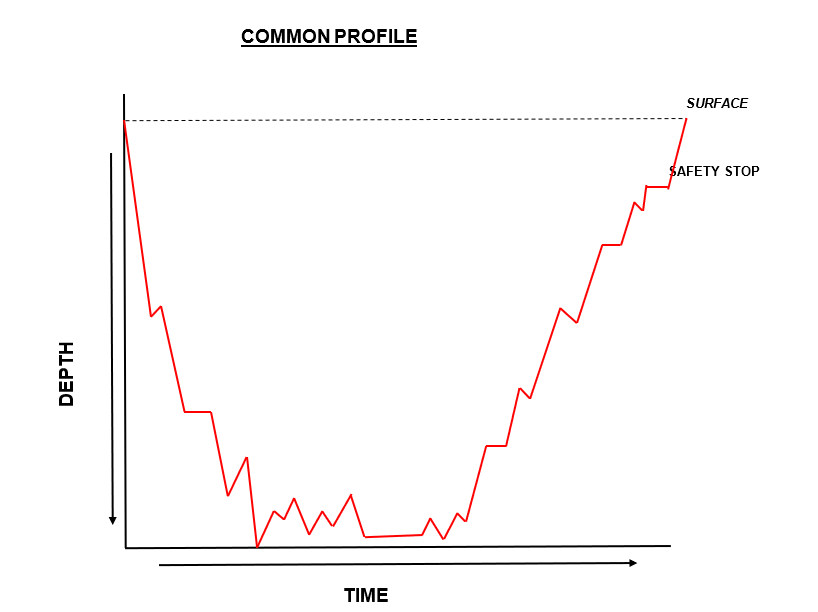
The above diagram is just one example of a common profile for the given recreational diver. But, what is serves to exemplify is the fact that multiple changes in depth occur throughout the dive. A table cannot account for this level of fine detail, meaning one of two things for the table diver. Either, the table diver will dive an extremely exact profile, which is near impossible and requires the diver, in most cases, to know the dive site very well. Or, conversely, the table diver will not actually dive the exact dive plan, but instead just a rough estimate of it. Now, of course, in the recreational shallow range, the latter is not much of a problem in reality, as the NDLs are very large and therefore the approximate plan will suffice. However, for anything in the deeper spectrum of the recreational range and beyond, this will present a significant issue.
The primary issue is that the NDL will be based on the planned profile, rather than the actual profile. This poses two problems, one of which will always be present. Either, the diver will have an overestimated NDL, meaning that they could actually stay longer at a given depth, and would also have larger NDLs for repetitive dives, resulting in shortened dives in both cases. Or, the reverse will occur, in which the diver will have an underestimated NDL, meaning that they may in fact have exceeded their NDL without realising. The consequence of this is that the diver will surface without performing any decompression stops, thereby increasing their risk of decompression sickness.
Another issue of tables is that of increased task loading. Diving with tables requires more pre-dive planning and calculation, as well as higher task loading during the dive. The table diver must maintain a diligent watch of their depth and time, as well as continuing to think as to how these values relate to the dive table. Now, of course, the diver with a dive computer should also be in a state of continual awareness regarding depth, time and NDL. However, a dive computer monitors depth, time and NDL, not to mention doing so with much more accuracy. This reduces task loading for the diver, allowing greater focus on other aspects of the dive experience, as well as giving them a back-up tool in case they forget to monitor their depth/time relationship at a given point during the dive. This gives the diver far more flexibility and freedom, allowing them to have greater total awareness of all aspects of the dive, rather than incessantly focusing on their depth, time and NDL.
It is, of course, as previously stated, possible to dive without a dive computer. However, given the convenience, accuracy and reliability of dive computers, there is little reason not to pick the best dive computer for yourself.
The Limitations of a Dive Computer
Despite the dive computer being an extremely reliable and accurate tool, it is only that: a tool. The dive computer is not a bulwark between you and decompression sickness. No Decompression Limits are calculated based on mathematical models, predicting nitrogen absorption and release and the body’s tolerance of such, expressed through the use of ‘tissue compartments’. Tissue compartments attempt to model the varying tissues of the human body, with some absorbing and releasing nitrogen at faster rates than others. The NDL is derived from these calculations to give a general limit that should be applicable to the majority of divers. The limitations of dive computers are best described by decompression theorist Karl E. Huggins:
“Behind the ‘black-and-white’ exactness of table entries, the second-by-second countdowns of dive computers, and beneath the mathematical purity of decompression models, lurks a dark and mysterious physiological jungle that has barely been explored.”
A dive computer runs numbers and calculations. It does not exonerate you from decompression sickness. It is false to think that by simply following the dive computer, every dive will end well. This is the argument many table divers put forward against the dive computer; that it creates a false sense of security. Of course, the dive computer may have the potential to do so, but it is not axiomatic that it will. The dive computer is a device which has revolutionised the dive experience, and, undoubtedly, increased diver safety since its birth. The point to emphasise, however, is that it does not grant you immunity from decompression sickness. There are multiple factors affecting the likelihood of decompression sickness, including but not limited to: dehydration, temperature, age, smoking, obesity, cardiovascular fitness, in-water exertion, dive profile, lung shunts, Patent Foramen Ovale (PFO), and previous DCS experience. Physiological and environmental factors play a major role in DCS incidence, hence why it is recommended to never push the limits of your computer.